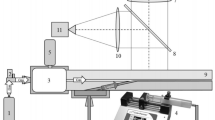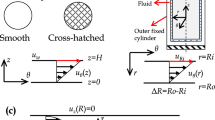Abstract
The aim of this work was to experimentally examine apparent rheological properties of fluids in microchannels based on pressure drop. Pressure drops of Newtonian and non-Newtonian fluids in microchannels were measured using pressure sensors. The effects of flow rate, Reynolds number, and viscosity of fluids on the pressure drop of single phase flow in microchannels were investigated, and the measurements of pressure drop were compared with prediction models. For Newtonian fluids, the friction factor in the laminar regime is f/2 = 26/Re. The results show that the pressure drop of Newtonian fluid is in good agreement with the prediction formula proposed by Cornish. However, the pressure drop of non-Newtonian fluid deviates from the theoretical prediction. A power-law is proposed for the relationship between the apparent viscosity of non-Newtonian fluid and the characteristic shear rate in a microchannel based on the pressure drop measurement. This relationship between the apparent viscosity and the characteristic shear rate in a specific microchannel is completely different from the rheological curve measured by cone-and-plate rheometer, due to the heterogeneous distribution of shear rates at the radial direction for non-Newtonian fluids flowing in a microchannel.









Similar content being viewed by others
Abbreviations
- Q :
-
Volumetric flow rate, m3 s−1
- ρ :
-
Density of fluid, kg m−3
- η :
-
Viscosity of fluid, Pa s
- k :
-
Consistency coefficient of fluid, Pa s–n
- n :
-
Flow characteristic index of fluid
- f :
-
Friction factor
- Re :
-
Reynolds number
- Re* :
-
Generalized Reynolds number
- ΔP :
-
Pressure drop, Pa
- u :
-
Velocity of fluid, m s−1
- D h :
-
Hydraulic diameter of microchannel, m
- τ w :
-
Wall shear stress, N
- \(\dot{\gamma }_{\text{w}}\) :
-
Apparent shear rate, s−1
- W :
-
Width of microchannel, m
- D :
-
Depth of microchannel, m
- L :
-
Length of microchannel, m
- w:
-
Wall of microchannel
References
Afzal A, Kim KY (2015) Convergent–divergent micromixer coupled with pulsatile flow. Sens Actuator B Chem 211:198–205
Akbari M, Sinton D, Bahrami M (2011) Viscous flow in variable cross-section microchannels of arbitrary shapes. Int J Heat Mass Trans 54(17–18):3970–3978
Al-housseiny TT, Christov IC, Stone HA (2013) Two-phase fluid displacement and interfacial instabilities under elastic membranes. Phys Rev Lett 111(3):034502
Armstrong RT, Mcclure JE, Berrill MA (2016) Beyond Darcy’s law: the role of phase topology and ganglion dynamics for two-fluid flow. Phys Rev E 94(4–1):043113
Ashish T, Satyendra SC (2019) Effect of varying viscosity on two-fluid model of pulsatile blood flow through porous blood vessels: a comparative study. Microvasc Res 123:90–110
Bahrami M, Michael Yovanovich M, Richard Culham J (2007) A novel solution for pressure drop in singly connected microchannels of arbitrary cross-section. Int J Heat Mass Trans 50(13–14):2492–2502
Bonn D, Eggers J, Indekeu J (2009) Wetting and spreading. Rev Mod Phys 81(2):739–805
Chen QL, Wu KJ, He CH (2015) Investigation on liquid flow characteristics in microtubes. AIChE J 61(2):718–735
Chevlier J, Ayela F (2008) Microfluidic on chip viscometers. Rev Sci Instrum 79(7):076102
Cuenca A, Bodiguel H (2013) Submicron flow of polymer solutions: slippage reduction due to confinement. Phys Rev Lett 110(10):108304
Dai GC, Chen MH (2015) Chemical fluid mechanics. Chenical Industry Press, Beijing
Duryyodhan VS, Singh SG, Agrawal A (2014) Liquid flow through converging microchannels and a comparison with diverging microchannels. J Micromech Microeng 24(12):125002
Fuerstman MJ, Lai A, Thurlow ME (2007) The pressure drop along rectangular microchannels containing bubbles. Lab Chip 7(11):1479–1489
Gupta S, Wang WS, Vanapalli SA (2016) Microfluidic viscometers for shear rheology of complex fluids and biofluids. Biomicrofluidics 10(4):043402
Henrik B (2004) Theoretical microfluidics. Oxford University Press, Oxford, pp 74–79
Jiang TQ (2004) Chemical rheology. East China University of Science and Technology Press, Shanghai
Judy JR (2011) Characterization of frictional pressure drop for liquid flows through microtubes. M.S. Thesis. Brigham Young University
Kandlikar SG, Schmitt D, Carrano AL, Taylor JB (2005) Characterization of surface roughness effects on pressure drop in single-phase flow in minichannels. Phys Fluids 17:100606
Kozicki W, Chou CH, Tiu C (1966) Non-newtonian flow in ducts of arbitrary cross-section shape. Chem Eng Sci 21:665
Kulkarni AA, Sebastian Cabeza V (2017) Insights in the diffusion controlled interfacial flow synthesis of au nanostructures in a microfluidic system. Langmuir 33(50):14315–14324
Kuttan BA, Manjunatha S, Jayanthy S (2019) Effect of variable viscosity on marangoni convective boundary layer flow of nanofluid in the presence of mixed convection. J Nanofluids 8(4):845–851
Li Z, Yu J, Ma CF (2006) The effect of pressure on single-phase frictional resistance in microchannels. J Eng Thermophys-Rus 06:1008–1010
Li Y, Ward KR, Burns MA (2017) Viscosity measurements using microfluidic droplet length. Anal Chem 89(7):3996–4006
Liu Y, Sun W, Wang S (2017) Experimental investigation of two-phase slug flow distribution in horizontal multi-parallel micro-channels. Chem Eng Sci 158:267–276
Livak-Dahl E, Lee J, Burns MA (2013) Nanoliter droplet viscometer with additive-free operation. Lab Chip 13(2):297–301
Macosko CW (1994) Rheology: principles, measurements and applications. Wiley, New Jersey
Morris CJ, Forster FK (2004) Oscillatory flow in microchannels. Exp Fluids 36(6):928–937
Pan L, Arratia PE (2012) A high-shear, low reynolds number microfluidic rheometer. Microfluid Nanofluid 14(5):885–894
Pomeau Y, Villermaux E (2006) Two hundred years of capillarity research. Phys Today 59(3):39–44
Roumpea E, Chinaud M, Angeli P (2017) Experimental investigations of non-newtonian/newtonian liquid-liquid flows in microchannels. AIChE J 63(8):3599–3609
Singhal V, Garimella SV, Murthy JY (2004) Low reynolds number flow through nozzle-diffuser elements in valveless micropumps. Sens Actuator A Phys 113(2):226–235
Suman C (2012) Microfluidics and microscale transport processes. CRC Press, Florida
Sun Y, Bai B, Ma Y (2014) Flow behavior characterization of a polyacrylamide-based friction reducer in microchannels. Ind Eng Chem Res 53(51):20036–20043
Tan XH, Jiany L, Li XP (2017) A complex model for the permeability and porosity of porous media. Chem Eng Sci 172:230–238
Tang GH, Lu YB, Zhang SX (2012) Experimental investigation of non-newtonian liquid flow in microchannels. J Non-Newtonian Fluid 173–174:21–29
Wang Y, Xu J, Yang C (2017) Fluid inhomogeneity within nanoslits and deviation from hagen-poiseuille flow. AIChE J 63(2):834–842
Weng X, Neethirajan S (2017) Ensuring food safety: quality monitoring using microfluidics. Trends Food Sci Tech 65:10–22
Yamada T, Hong C, Gregory OJ, Faghri M (2011) Experimental investigations of liquid flow in rib-patterned microchannels with different surface wettability. Microfluid Nanofluid 11:45
Yao CQ, Zhao YC, Chen GW (2018) Multiphase processes with ionic liquids in microreactors: hydrodynamics, mass transfer and applications. Chem Eng Sci 189:340–359
Zhang P, Yao CQ, Ma HY (2018) Dynamic changes in gasliquid mass transfer during Taylor low in long serpentine square microchannels. Chem Eng Sci 183:17–27
Acknowledgements
The financial supports for this project from the National Natural Science Foundation of China (No. 21878212, 91634105, 21776200, 21576186), and the Tianjin Natural Science Foundation (17JCQNJC05300) are gratefully acknowledged.
Author information
Authors and Affiliations
Corresponding author
Additional information
Publisher's Note
Springer Nature remains neutral with regard to jurisdictional claims in published maps and institutional affiliations.
Electronic supplementary material
Below is the link to the electronic supplementary material.
Rights and permissions
About this article
Cite this article
Yang, X., Weldetsadik, N.T., Hayat, Z. et al. Pressure drop of single phase flow in microchannels and its application in characterizing the apparent rheological property of fluids. Microfluid Nanofluid 23, 75 (2019). https://doi.org/10.1007/s10404-019-2241-y
Received:
Accepted:
Published:
DOI: https://doi.org/10.1007/s10404-019-2241-y




